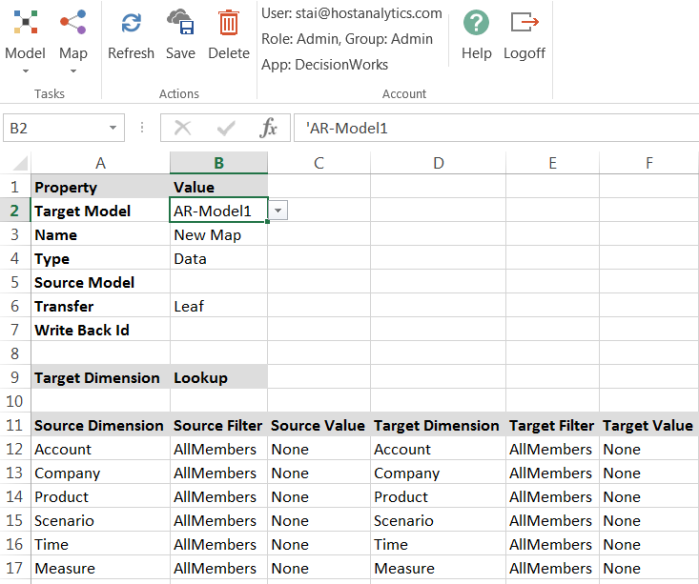- 3 Minutes to read
- Print
- DarkLight
- PDF
How to Create a Map
- 3 Minutes to read
- Print
- DarkLight
- PDF
- Select the Model task and the Map subtask.
- Select the Target Model, which is the model you want to copy data and/or metadata to.
- Enter the name of the map (for example, the name of the Target Model).
- For Type, select Metadata to copy only metadata from the source to the target model. Select Data to copy only data from the source to the target model. Select Both to copy both metadata and data from the source to the target model. Lookups apply to Metadata. Make sure you select Metadata or Both if you plan to use the Lookup functionality.
- In the Source Model cell, select the model to copy data and/or metadata.
- For Transfer, select Leaf to transfer leaf level dimension members only. Select All to transfer all members from the source to the target model.
- The Write Back ID is optional and only required to write data back from a model to Planful Structured Planning, Consolidation, and Reporting applications. See: Write Back Process in Dynamic Planning.
- The Access Token is optional and only required to move data from one Dynamic Planning application to another. See: How to Move Data from One Dynamic Planning Application to Another.
- Use Target Dimension/Lookup to customize dimension member labels for display within a model or an analysis.
- For the Source/Target Dimension, enter the dimension that exists in the source/target model that you plan to copy data and/or metadata from and to.
- In the Source/Target Filter cell, select from one of the following options:
- AllMembers – Map all members from the source model to the target model.
- LevelAndAbove – Members at a specified level number as well as all members above that level in the hierarchy will be mapped.
- MemberAndBelow - Members at a specified level where a member name exists as well as all members below that level in the hierarchy will be mapped.
- FixedMember – The dimension displays data from a set member based on the member name. For example, the scenario dimension only displays a 2013 Budget scenario, and all other scenarios (Actual, What If, etc.) are not mapped.
- DimensionFilter – The dimension is filtered from view in the model so that the dimension and all members are hidden in the target model. Specify a dimension name (for example, Project) in the Value field.
- None – This dimension either doesn’t exist in the source model and needs to be mapped to a FixedMember in the target model or the dimension doesn’t exist in the target and the entire dimension will be mapped to None. All members will be excluded from the target model.
- For Source/Target Value, your selection is based on the source/target filter. There are two options; either the value is not specified for the dimension so all members are displayed (None). Or, the value is specified meaning that all data associated with that value is displayed. Various combinations of dimension values represent a unique combination.
One-to-One Mapping
A One-to-One mapping happens when the source filter and value are equal to the target filter and value. In the image below, all members from each dimension (Account, Company, Scenario, and Time) in the source model are mapped to all members of each dimension in the target model. This is a one-to-one mapping

Another example of a one-to-one mapping is a Fixed Member mapped to another Fixed Member of the same value as depicted below.

One-to-Many Mapping
A One-to-Many mapping happens when the source filter and value are less than the target filter and value. For example, let’s say you want to map the data for one scenario dimension to all scenarios. There are several reasons you might want to do this. For example, you want all scenarios to start with Actual data so you map Actual to your 2014 Q1 scenario, 2014 Q2 scenario, and so on as shown below.

One-to-many mappings for fixed member types are also supported. For example, move budget data to different budget scenarios to perform variance exchange analysis or move data from one department to multiple new departments so that it can be used as a baseline.

